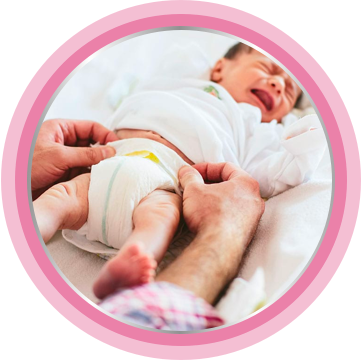Learn about nappy rash
At Bepanthen®, we understand that there’s nothing more precious than your little ones, that’s why we’ve spent more than 50 years caring for their beautifully delicate skin3.
Babies’ skin is thinner and softer than ours, and much more sensitive12. It also has a higher pH level13, which makes it more sensitive to irritants. Although unpleasant for you and your baby, nappy rash is extremely common and easy to manage with the right care, like using proper nappy rash ointment at every diaper change6. If your baby has nappy rash, please don’t feel like you’ve done something wrong – it happens to all of us.
With a combination of scientific expertise and a passion for family healthcare, Bepanthen have formulated a range of preservative-free, fragrance-free and colourant-free baby creams to protect your baby’s precious skin1.
What is nappy rash6,14,15? Can an ointment help?
Nappy rash can occur at any time during your child’s nappy-wearing stage. Most children will experience nappy rash during this time, which appears as redness, lesions, swelling or spots on your baby’s bottom, thighs and genitals. Their affected skin may also be hot to the touch.

The risk of nappy rash changes as your baby grows. During the first twelve months, nappy rash is especially common, as stools are more frequent, and your baby’s skin is thinner, more permeable, and has a higher pH level. That’s why we’ve formulated Bepanthen® Nappy Care Ointment that is suitable from birth.
Remember, nappy rash is incredibly common, but there's a simple way to help to protect against the causes by using a barrier nappy ointment like Bepanthen® Nappy Care Ointment.
If nappy rash does develop, try not to worry, as there are treatments available. If it’s been a few days and in spite of treating it is still spreading outside the nappy area, and if the skin is broken and weeping, or your baby is feverish, there may be an infection. Again these symptoms are common and not necessarily a cause for alarm, but you should consult a doctor.
How does nappy rash affect your baby?
Your baby’s behaviour might seem more troubled – they may cry when touched or washed and wake frequently in the night because of discomfort.

Causes of nappy rash6
The most common cause of nappy rash is a combination of soiled nappies and friction. A baby’s delicate skin becomes sore and fragile when in contact with the natural, yet irritating chemicals in healthy urine, and the irritants and enzymes in faeces.
This is made worse by a tight nappy, which both rubs, removing the skin’s protective lipids, and stops air circulating. If left untreated, this can even lead to fungal infections such as candida albicans (thrush). Some baby wipes and cleaning products can also cause irritation.
Nappy rash is more likely to occur if your baby is
- Premature
- Unwell
- Recovering from vaccination
- Suffering from diarrhoea (which may be caused by certain medications, e.g. antibiotics or change in diet)
- Weaning
- Prone to hereditary eczema

When should you see the doctor?
Remember, nappy rash is incredibly common, but there is a simple way to help to protect against the causes by using a barrier like Bepanthen® Nappy Care Ointment.
If nappy rash does develop, try not to worry as there are treatments available. If it’s been a few days and in spite of treating the rash is still spreading outside the nappy area, and if the skin is broken and weeping, or your baby is feverish, there may be an infection. Again these symptoms are common and not necessarily a cause for alarm, but you should consult a doctor.
References:
1. Atheton et al (2015).
2. Data on file. Bepanthen® Itch Relief Cream
3. Bepanthen® historical milestones. More than 70 years of Bepanthen®: The miracle of healing
6. Prokscha E, et al. Topical use of dexpanthenol: a 70th anniversary article. Journal of dermatological treatment. 2017. (28:8). p 766-773
12. G. N. Stamatas et al. Infant skin physiology and development during the first years of life: a review of recent findings based on in vivo studies. International Journal of Cosmetic Science, 2011, 33, 17–24
13. Sarkar R et al. Skin care for the newborn. Indian Pediatrics. 2021. (47) p. 593 – 598
14. http://medlineplus.gov/ency/article/000964.htm
15. http://my.clevelandclinic.org/childrens-hospital



